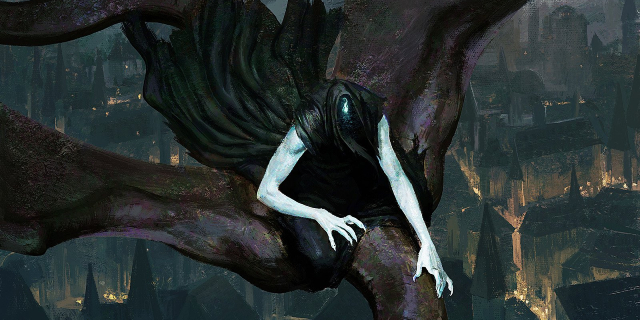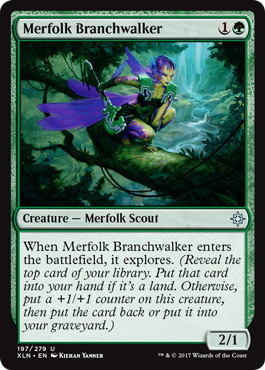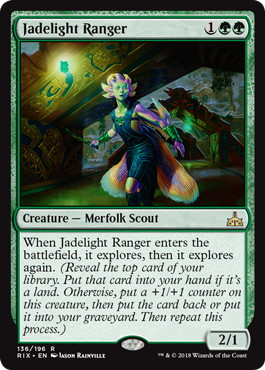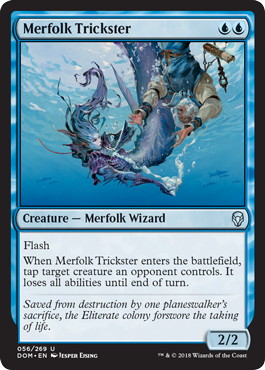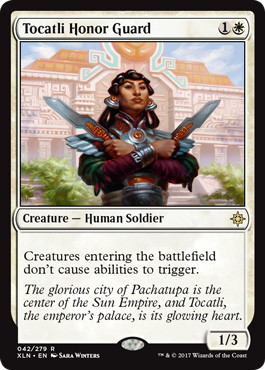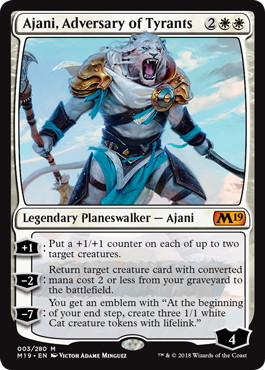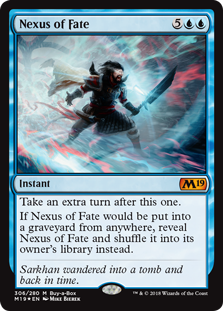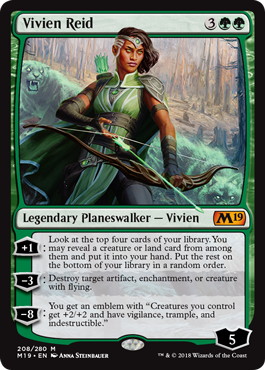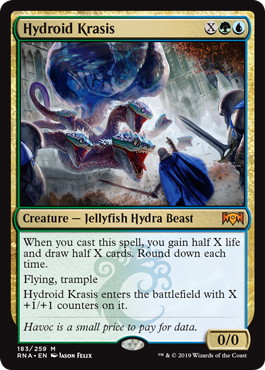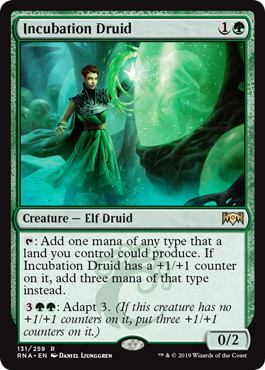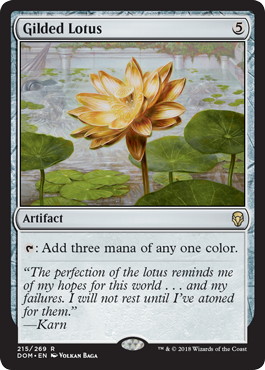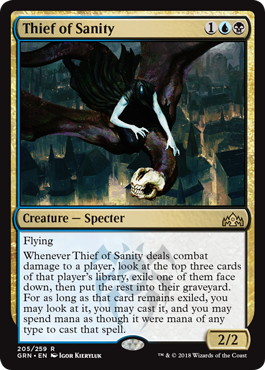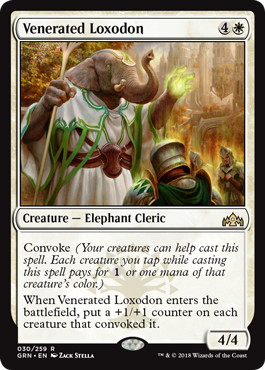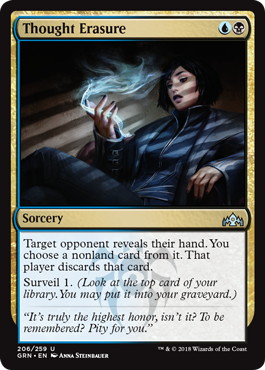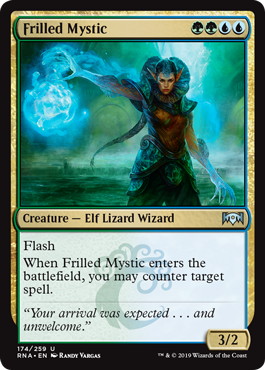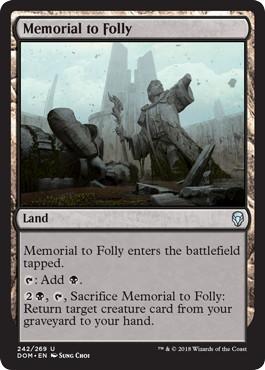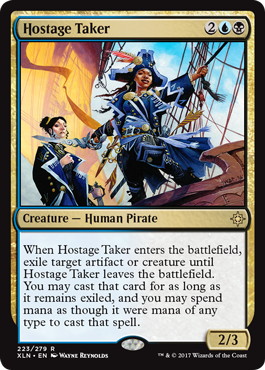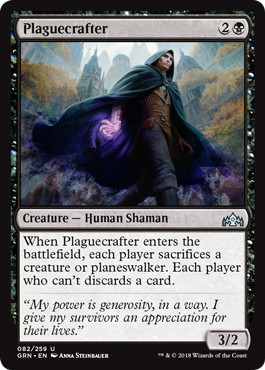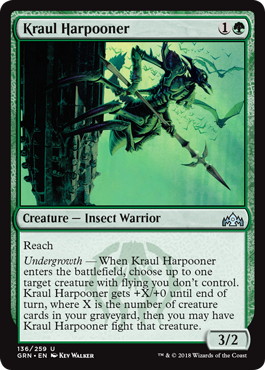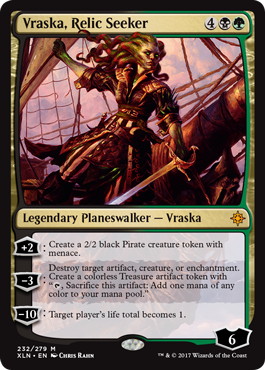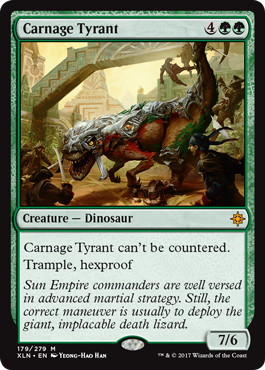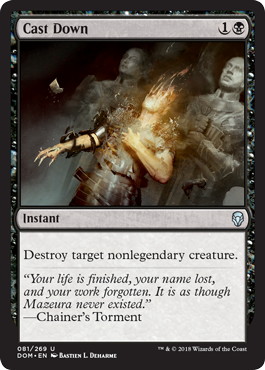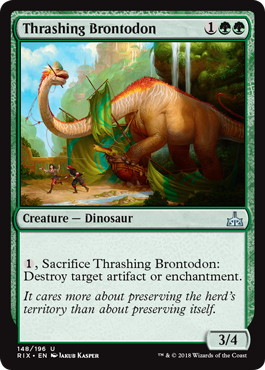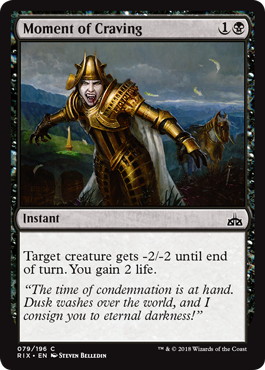Introduction
Mythic Championship I in Cleveland last weekend was an interesting one, preparation-wise. With the emergence of the Magic Pro League, many of the toughest competitors streamed a large portion of their preparation on Twitch. That created an unique landscape, much different than typical secretive way in which pro teams try to gain an edge over one another – you could feasibly gain information about what other players are thinking and where are they leaning. In fact, I myself streamed games with 74/75 of a deck that I ended up registering Tuesday before flying out to the tournament.

Image Copyright : Wizards of the Coast
I used this influx of more open Magic content to build the decklist I ended up playing at the Mythic Championship. Interestingly, I wouldn’t get there, had I not been able to expand on other player’s work, but at the same time, some of the conclusions I arrived to seem to differ from general consensus. Nonetheless, I had barely ever felt as confident and comfortable in my decklist before a tournament, so let me explain how I arrived there.
Decklist
This is the decklist I used to place 24th, going 8-2 in constructed:
- Piotr Glogowski
- – Omega Sultai
- Mythic Championship I Cleveland
- (8-2)
1 《Island》
4 《Breeding Pool》
4 《Overgrown Tomb》
4 《Watery Grave》
4 《Drowned Catacomb》
4 《Woodland Cemetery》
2 《Hinterland Harbor》
-Lands (25)- 4 《Llanowar Elves》
4 《Hydroid Krasis》
4 《Incubation Druid》
4 《Thief of Sanity》
1 《Jadelight Ranger》
3 《Hostage Taker》
1 《Frilled Mystic》
-Creatures (21)-
2 《Cast Down》
1 《Assassin's Trophy》
2 《Vraska's Contempt》
2 《Find // Finality》
3 《Vivien Reid》
1 《Vraska, Relic Seeker》
-Spells (14)-
2 《Thrashing Brontodon》
2 《Duress》
2 《Moment of Craving》
2 《Negate》
1 《Plaguecrafter》
1 《Frilled Mystic》
1 《Disdainful Stroke》
1 《Cry of the Carnarium》
1 《Vraska, Relic Seeker》
-Sideboard (15)-
Most notably, my decklist omits the Explore creature package entirely, using 8 mana dorks instead.
Seeing how universally adopted running the entire 12 Explore cards in Sultai decklists before this Mythic Championship really got me thinking. One of the more hyped decks coming into week one of Ravnica Allegiance Standard was Mono-Red, powered up by new cards in 《Light Up the Stage》 and 《Skewer the Critics》, essentially becoming a Burn deck instead of an Aggro deck anymore. Naturally, an intuitive reaction is to run a proven and maindeckable source of lifegain in your prototype builds of Midrange. Seems extremely reasonable, but Mono-Red just flopped hard, so hard that I had no interest in testing the matchup extensively before the Championship.
If you look at how Guilds of Ravnica Standard had developed, 《Wildgrowth Walker》 was indeed a huge part of the archetype, yet definitely not a universal four-of. Sometimes it was only sideboarded, other times only a few copies were included. It was basically a metagame choice on how hard you go for 《Wildgrowth Walker》. Nowadays it is stock to run 3 playsets of 《Merfolk Branchwalker》, 《Jadelight Ranger》, and 《Wildgrowth Walker》. Where I am failing is understanding why that would be a natural conclusion.
Premier Aggro decks of the format are going to be moving forward even more after Autumn Burchett’s win in Cleveland, Mono-Blue, and to lesser extent, White Weenie. Mono-Red is nowhere to be seen, failing drastically despite being a heavily hyped deck at the beginning of the format. 《Skewer the Critics》 and 《Light Up the Stage》 failed to deliver, and red was (unsurprisingly to no one) nowhere to be seen at the Mythic Championship.
While 《Wildgrowth Walker》/ Explore package is functional good against those archetypes, it is not perfect in either one of those – there is a lot of “if”s when it comes to your perfect 《Wildgrowth Walker》/《Jadelight Ranger》 curve when facing Mono-Blue, avoiding getting either one countered, dodging 《Merfolk Trickster》, and actually have the sizing and lifegain matter, which might not always the case through 《Curious Obsession》 or 《Tempest Djinn》.
And while 《Wildgrowth Walker》 itself is great against 《History of Benalia》 and friends in game 1, the same can’t be said about the Explore creatures, and I generally haven’t found running head-first into their developed 《Tocatli Honor Guard》/《Dauntless Bodyguard》/《Ajani, Adversary of Tyrants》 sideboard plan which is an overly successful approach. The best matchup for 《Wildgrowth Walker》 is buried deep in Tier 2.
The bigger decks of the format ignore 《Wildgrowth Walker》 completely. 《Teferi, Hero of Dominaria》 Control shifted from Jeskai to Esper, relying on 《Kaya's Wrath》 and not on 《Deafening Clarion》 as their primary sweeper. 《Wildgrowth Walker》 is a meaningless threat alone, so it forces you to always overextend into a sweeper to gain any value from it. 《Nexus of Fate》 decks just shrug off the anemic clock, especially if you ever draw our 《Wildgrowth Walker》 after you played your 《Jadelight Ranger》. Mirror match became largely about 《Hydroid Krasis》 wars, and 《Wildgrowth Walker》 is a pretty miserable card to draw off your 《Hydroid Krasis》.
To me, it was apparent that 《Wildgrowth Walker》 is overall not the thing I want to be doing in most of my matchups. The surrounding cast of 《Merfolk Branchwalker》 was praised for its ability to help you smooth out your draws and maximize the ability to hit land drops. The problem with those is that they are more or less more vanilla stats in your deck. With the value of a land card being dynamic, their power level can vary from card-advantage producing bodies or reasonable stats smoothing your draws to meaningless vanillas with Scry 1 attached. In the end, they certainly do help 《Hydroid Krasis》, but they don’t maximize 《Hydroid Krasis》 by any means.
The way Sultai decks in early Ravnica Allegiance format were built was just a mild evolution on Golgari decks from Guilds of Ravnica with the addition of the obvious constructed bomb 《Hydroid Krasis》. While it is not impossible for the simplest approach to be the best one, some of the dynamics have changed. Golgari was basically 《Vivien Reid》 + filler to make her work; now with 《Hydroid Krasis》, Sultai has two real power cards. I want for my 《Vivien Reid》 to find my 《Hydroid Krasis》, and I want for my 《Hydroid Krasis》 to refuel my hand with a fistful of relevant cards, ideally interaction.
- Piotr Glogowski
- – Omega Sultai
- Updated List after Mythic Championship
1 《Island》
4 《Breeding Pool》
4 《Overgrown Tomb》
4 《Watery Grave》
4 《Drowned Catacomb》
4 《Woodland Cemetery》
2 《Hinterland Harbor》
-Lands (25)- 4 《Llanowar Elves》
4 《Hydroid Krasis》
4 《Incubation Druid》
4 《Thief of Sanity》
1 《Jadelight Ranger》
3 《Hostage Taker》
1 《Frilled Mystic》
1 《Carnage Tyrant》
-Creatures (22)-
2 《Cast Down》
1 《Assassin's Trophy》
2 《Vraska's Contempt》
2 《Find // Finality》
3 《Vivien Reid》
-Spells (13)-
2 《Thrashing Brontodon》
2 《Duress》
2 《Moment of Craving》
2 《Negate》
1 《Frilled Mystic》
1 《Disdainful Stroke》
1 《Vraska, Relic Seeker》
-Sideboard (15)-
Notable Cards
While the Explore team makes it easier to survive to the lategame where you can cast huge 《Hydroid Krasis》, you can alternatively just accelerate to that game state, assuming a more late-game oriented approach. If your main plan is to accelerate into 《Hydroid Krasis》, then you need for your cards to be better in the late game than basically vanilla Explore dudes. The nice thing is that your deck is naturally going to go bigger, because the mana dorks are going to stick around, making your 《Hydroid Krasis》 chain go smoother in the mirror match. In the end, I replaced the Explore package with those cards:
4 《Incubation Druid》
The Adapt ability on this card seems like flavor text at first, but it was consistently the most impressive part of the card to me. Setting up for a sizable early 《Hydroid Krasis》, blocking 《Adanto Vanguard》, out-manaing Mono-Blue, surviving 《Find // Finality》 and being a decent top-deck for a 2-drop were all real and happened to me in the tournament. 《Gilded Lotus》 combines well with X spells. The big downside is giving up the beats potential of 《Merfolk Branchwalker》, but if you want to produce mana, 《Incubation Druid》 just outperforms 《Merfolk Branchwalker》.
4 《Thief of Sanity》
《Thief of Sanity》 is another on-curve replacement. Coming in for 《Jadelight Ranger》, you gain another advantage in the mirror match, replacing a lukewarm monster with a must-deal-with threat. While it is far from just-game winning, the level of attention it requires and card advantage potential is far over one expected out of a 3-drop.
What surprised me was its effectiveness against both aggressive decks. It looks like a card that is not great when you are trying to defend yourself, and it indeed trades horribly on mana when facing 《Shock》, but again – Mono-Red is not a deck this format. Both other Aggro decks are removal-light. Against Mono-Blue, a 2/2 flying blocker is worth a lot. Against White Weenie, it turns out that consistently double-spelling and flooding the board with extra 1-drops is an excellent way to contain the board. Surprisingly, what I thought at first was a concession to the mirror match ended up being an improvement against virtually all the matchups. 《Thief of Sanity》 was supposed to be actively bad against Aggro, but that just wasn’t my experience, which left it as an overall-incredible cheap threat.
3 《Thought Erasure》
《Thought Erasure》 was dubbed to be the best card in Standard by some writes earlier in the format, but I consider it to be merely strong. Again, it is non-intuitive, but discard spells just happen to line up well against Aggro of this format. 《Thoughtseize》 effects are a good way to punch a hole in Mono-Blue Aggro’s game plan, and against White Weenie, you rarely lose to random small beaters, it is always one of their power cards that’s at fault, most often 《Venerated Loxodon》. 《Thought Erasure》 is a way to deal with those. That makes your discard spell a potent weapon against most matchups.
Outside of White Weenie, decks rarely end up topdecking in this Standard format, too, which lessens an extent to which playing 《Thought Erasure》 would be a liability – you can always fire off the discard spell after your opponent topdecks and taps out for a 《Hydroid Krasis》 in a mirror match, for example. An overall increase in available ways to interact is always welcome, too. Surveil 1 basically steps in for 《Merfolk Branchwalker》‘s Explore ability too as far as your mana is concerned.
1 《Frilled Mystic》
《Frilled Mystic》 was somewhat of a fun-of, but with a clear purpose – it’s a generally reasonable late card, and the first copy is going to be findable by 《Vivien Reid》. Since you will have trouble pressuring life totals, having access to at least some stack interaction is pretty huge against 《Wilderness Reclamation》 and Control decks. You can hide it under a 《Hostage Taker》 in those matchups’ game 1, too.
Mana Base
Two challenges that come with including this set of cards lessened early game battlefield presence and required a more demanding mana base. I definitely needed to run 25 lands, and I knew from the beginning that I would be skipping 《Memorial to Folly》 – can’t justify a single-colored tapland that doesn’t enable my Checklands. I would want to cast sideboarded counterspells anyways, so I would be extremely wary of including 《Memorial to Folly》 in my mana base anyways.
The biggest concession, in the end, is a somewhat limited amount of turn 1 green sources for my 《Llanowar Elves》. With 10 green sources on turn 1, I am only around 80% to cast it on turn 1, even less so if I want to curve 《Llanowar Elves》 into a 《Thief of Sanity》, but since I am more interested in powering out a giant 《Hydroid Krasis》 than jumping from 1 to 3 mana, I was fine with odds of 《Llanowar Elves》 on turn 1 being lackluster. 《Incubation Druid》 helps with double-spelling with those sometimes difficult costs later in the game.
Basic Game Plan
Since you have less early battlefield presence, this decklist now leans towards playing the Control role in most matchups. You can’t frequently race, so you have to focus on building incremental advantages. One might be worried about 《Vivien Reid》 being way worse in surviving without the cast of small creatures to protect her, but it rarely plays out this way. One of her big qualities is her humongous loyalty. You can play her safely into a 3(!) power creature, after all. Typical play patterns are searching for either a 《Hostage Taker》 or a 《Hydroid Krasis》 to stabilize the next turn after you play her.
The lack of early-game power hurts more against 《Nexus of Fate》 and 《Teferi, Hero of Dominaria》. I tried to remedy that by running 《Growth-Chamber Guardian》, but they are pretty lackluster across most matchups, being a mana-hungry card in an already mana-hungry deck. Mostly you are looking for your sideboard to cover for you there, but you can steal games with 《Thief of Sanity》.
Overall, it’s either that I’m just wrong, or it just so happened and a strong positive feedback 《Wildgrowth Walker》 loop has developed, tricking way too many players into running those cards. While I won’t know for sure, I will repeat that the deck ran very smoothly, and I was very happy with what I have prepared for the tournament. Since I was preboarded for the mirror match, I filled my sideboard with cheap pinpoint interaction aggainst Aggro and Control. Generally speaking, your spells are amongst the best ones in the format, so mostly you should be fine.
Going forward, I would probably replace 《Cry of the Carnarium》 and 《Plaguecrafter》 with 2 extra 《Kraul Harpooner》 – this was a card I was too tame on. The popularity of 《Kraul Harpooner》 amongst well-performing Sultai lists at Cleveland, in addition to Mono-Blue taking the entire event down signals to me that I should have gone harder on those. 《Plaguecrafter》 was a Vivienable removal to 《Teferi, Hero of Dominaria》, which I overprepared for, while 《Cry of the Carnarium》 is generally only good versus White Weenie, and it’s even arguable there when I run so many creatures that die to it myself.
I would also replace a copy of 《Vraska, Relic Seeker》 with a 《Carnage Tyrant》. While it was shunned before the tournament, many players chose to run it; even if it’s not the centerpiece of the mirror match anymore, and control decks replaced their 《Deafening Clarion》 with 《Kaya's Wrath》, the first one unlocks enough of a unique effect that I should have ran it over a 《Vraska, Relic Seeker》.
The Matchups
Mirror Match (with Explore guys)

In Mirror Match:
《Cast Down》 is used to get cut in the mirror, but is a good card now due to blue creatures, but you still might want to board one out on the play over 《Llanowar Elves》. 《Carnage Tyrant》 can be dealt with a 《Thought Erasure》, Adapted 3/5 《Incubation Druid》, or 《Hydroid Krasis》 just going over the top of it, but in some contexts, it can be tough when combined with 《Find // Finality》. This is why I want to run one now. Other than that, this is just your regular Midrange Magic with the Exploreless deck going slightly bigger and therefore having an advantage.
If given an opportunity, Adapting 《Incubation Druid》 before you tap out for 《Hydroid Krasis》 creates cascading advantages. 《Thought Erasure》 could be discarding around potential tempo early in the game, because you do want to try running away with a 《Thief of Sanity》 or a planeswalker, but otherwise you should discard around 《Hydroid Krasis》 wars – choosing 《Hostage Taker》, 《Find // Finality》, and Jellyfish Hydra itself.
Esper Control

Against Esper Control:
In a typical Control vs Midrange way of lately, your Esper opponent is most likely going to out-Teferi you in game 1, before you board a dozen or so of cards and you win both postboard ones. Can also steal a preboard one with a 《Thief of Sanity》.
With a full playset of 《Kraul Harpooner》, you get to just leverage those as your early plays and not worry about their 《Thief of Sanity》 probably ever. Their 《Hostage Taker》 can be troublesome, but I don’t really want to have 《Cast Down》, and between 《Vraska's Contempt》, 《Assassin's Trophy》, 《Disdainful Stroke》, 《Frilled Mystic》, and 《Thought Erasure》 you should have enough counterplay against that. With 17 creatures, you might need to take a land with 《Vivien Reid》 sometimes, but it’s all fine.
Prioritize killing 《Search for Azcanta》 over most other concerns, because 《Azcanta, the Sunken Ruin》 can easily beat you. Control players always describe their matchup against Midrange as good, but I never want to be on the side of easily exploitable strategies in Standard.
White Weenie

Against White Weenie:
As I mentioned before, 《Thief of Sanity》 is just surprisingly good in this matchup. During my preparation for the tournament, many White Aggro opponents confused my deck for an Explore variant, and ended up boarding into their 《Tocatli Honor Guard》 plan. Given that 《Venerated Loxodon》 is their best card against, you, it’s nice.
I faced White Aggro twice in the tournament and I took one of my losses to Max McVety, who I believe smartly didn’t board in 《Tocatli Honor Guard》 and ran me over with the Elephants. My other opponent ran me over in game 1 and had really slow draws with a 1/3 no abilities creature in game 2 and 3, so go figure.
It’s possible that the “true” matchup against an opponent knowing and fully respecting your list is tougher. At the Mythic Championship, I was cutting my discard spells, but 《Thought Erasure》 is the best countermeasure against 《Venerated Loxodon》; you’ll deal with the small dudes and eventually cast a huge 《Hydroid Krasis》. I think I was making a mistake and I would keep them now.
Mono-Blue

Against Mono-Blue:
Your way to win is almost never to outrace them, but to outmana them and multispell. The entire Mono-Blue deck is good, because it spends way less mana on its cards. Mana dorks help emulate matching them. Adapting 《Incubation Druid》 when possible is usually a good idea, trying to tie that into a huge 《Hydroid Krasis》 or a discard spell followed up with an interaction spell or two.
What can be scary is 《Entrancing Melody》; before the Mythic Championship, I haven’t seen too many of those in the maindecks online, now people are gravitating towards 1 main, and it can be tough.
I believe 《Vivien Reid》 to be decent in this matchup, but mostly because 《Incubation Druid》 helps leverage her. I’m not even sure if 《Carnage Tyrant》 isn’t good enough for the same reason.
《Hostage Taker》 can be awkward if they 《Dive Down》 their only creature before it resolves, you will need to steal your own creature. If you can contain them and play a huge 《Hydroid Krasis》, you will win. This matchup can be tough to get a feel for, because good Mono-Blue players will beat you much more frequently than somebody that picks the deck up for the first time.
Simic Nexus

Against Simic Nexus:
The exact mix of removal to leave in your deck is tough to figure out, but you don’t want to die to 《Biogenic Ooze》 too hard. 《Thought Erasure》/《Disdainful Stroke》/《Frilled Mystic》 helps there. Leaving at least a single 《Hostage Taker》 to find with 《Vivien Reid》 makes sense.
Their best card is 《Search for Azcanta》. You will most often be able to contain them with interaction unless they stick and flip one. Go out of your way to kill it. Sometimes that means thinking twice about attacking with your 《Thief of Sanity》, because it mills them. With 《Incubation Druid》, casting their stolen 《Nexus of Fate》 is real.
Conclusion
Overall, again, I was extremely pleased with this build and I would still recommend it going forward with the proposed changes. Especially if your playstyle favors defensive-leaning Midrange, like mine does, this deck plays strong cards, has no glaring weaknesses, and is tons of fun.
Take care,
kanister @kanister_mtg on Twitter, Twitch


